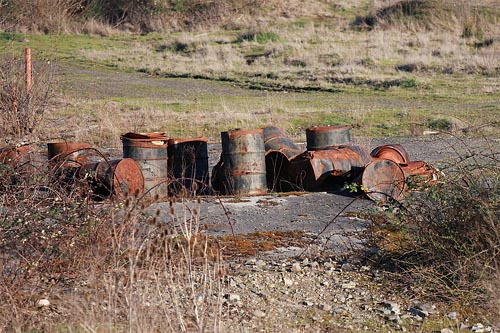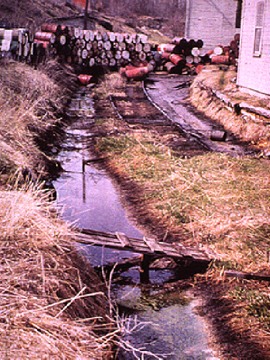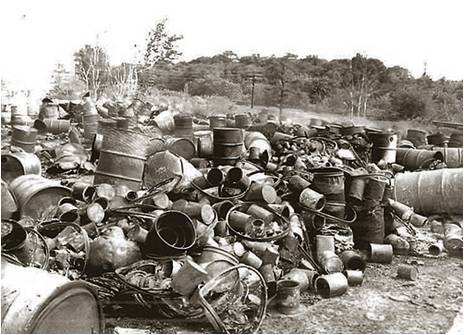- hot-spots
- chemical pollution
- USA
- The Case of Water Pollution in Woburn, MA

Problems
Chemical Pollution Hotspot in Woburn
Woburn, Massachusetts, is a town located about 10 miles north of Boston. In the mid-20th century, Woburn became known for a high incidence of leukemia among children, which was ultimately due to Woburn water contamination from local industrial plants.
Causes of chemical pollution in Woburn
Pollution in Woburn was primarily caused by dumping industrial waste, including toxic chemicals such as trichloroethylene (TCE) and perchloroethylene (PCE), in leaky disposal sites. This led to widespread Woburn water contamination. From 1954 to 1978, W.R. Grace operated a tannery in Woburn that dumped toxic chemicals into the soil and groundwater, contributing to Woburn, Massachusetts, water contamination. Another company, Beatrice Foods Co., operated a food processing plant that also contributed to the pollution. These plants contaminated groundwater, which local residents used as drinking water, resulting in severe Woburn water issues.
Implications for local residents
Woburn residents have had a high incidence of leukemia and other diseases as a result of the contamination. Some affected children's families have sued the companies responsible for the Woburn water contamination, claiming that their negligence caused the illnesses. Studies have shown that trichloroethylene can increase the risk of leukemia, especially in people exposed to high concentrations of the substance for long periods. This is because TCE can disrupt the normal functioning of the immune system and cause mutations in the genetic material of cells. This is a significant concern for those affected by Woburn, Massachusetts, water contamination. In addition, TCE can be responsible for other types of cancer, such as liver, kidney, and lung cancer. It can also lead to other diseases such as autoimmune diseases and diseases of the nervous system, highlighting the severe health risks associated with Woburn water contamination.
Conclusions
The Woburn contamination serves as an instructive example of the importance of responsible waste management and the possible consequences of failing to properly manage toxic chemicals. The incident of Woburn, Massachusetts, water contamination also led to changes in environmental regulations and increased public awareness of the dangers of chemical pollution. The legacy of environmental contamination in Woburn continues to this day, and efforts are underway to remediate contaminated groundwater and soil. The Woburn Environmental Working Group, a post-trial community organization, continues to advocate for environmental justice and public health in Woburn and beyond, focusing on resolving ongoing issues related to Woburn water contamination.
Gallery
6Timelines
2024
May
Woburn Senior Center Water Dispenser PFAS Test Results 2.73 ppt (“part per trillion” or “ppt” is a microscopic measurement for substances in the water and is equivalent to a single drop of water in the combined water volume of 20 Olympic-sized swimming pools).
2023
August 22
A sample result taken on Aug. 2 at the Horn Pond Water Treatment Plant in Woburn measured 22.9 ng/L, and a second August sample, taken on Aug. 22, was 19.6 ng/L. This made the monthly average 21 ng/L. However, according to officials, a PFAS6 MCL violation has not occurred because violations are determined by a quarterly average based on three months of testing unless any single sample result would cause the quarterly average to exceed the MCL. "City in compliance with Mass DEP PFAS6 MCL. This is (the) 4th consecutive quarter of compliance with MassDEP regulation dating back to October 2022," Woburn Mayor Scott Galvin said in a statement. The City of Woburn also has taken several steps to address PFAS6 levels in the drinking water and their impacts. City officials said Woburn is upgrading its water treatment plant to remove PFAS6, and that a design is nearly complete and will be submitted to MassDEP for approval by the end of the month.
2021
December 08
Woburn water tested above the state's maximum contaminant limit for PFAS, sometimes called forever chemicals, across third quarter tests, the city said in a letter some residents received Tuesday. The city's water again tested above the limit in October before falling just below it in November, according to an update on the city website. The city's water tested on average at 24 parts per trillion across five tests from July to Sept., according to the letter. The state maximum contaminant level for drinking water, set in Oct. 2020, is 20 parts per trillion.
2011
May 22
Nearly 30 years after that landmark court case, the wells that supplied both toxic drinking water and a legacy of cancer to Woburn remain contaminated despite a $21 million cleanup effort. And no one, not even the U.S. Environmental Protection Agency which monitors the site as part of the federal Superfund program, knows whether humans are still being exposed to its witch's brew of chemicals, federal records show.
2000
December 09
The EPA completes a cleanup plan for the wells in Woburn, which includes the construction of a treatment plant to remove contaminants from the water.
1995
September 23
The EPA designates the wells in Woburn as a Superfund site, meaning that they are among the most polluted sites in the country and require long-term cleanup efforts.
1990
July 05
A settlement is reached between the plaintiffs and the defendants. W.R. Grace and Beatrice Foods agree to pay a total of $69.5 million in damages.
1986
November 17
A jury finds W.R. Grace and Beatrice Foods liable for contaminating the wells in Woburn and causing the illnesses of the affected children.
1984
January 23
The lawsuit goes to trial. During the trial, evidence is presented that suggests that W.R. Grace and Beatrice Foods knew about the contamination of the wells but did not take adequate action to address the problem.
1981
January 23
The Massachusetts Department of Public Health and CDC released an additional study that and concluded that the incidence of childhood leukemia in Woburn was significantly greater than expected. This study got around the lack of information in the rest of the state by using age- and sex-specific incidence data from the Third National Cancer Survey (TNCS). A group of families affected by childhood leukemia in Woburn file a lawsuit against W.R. Grace and Company and Beatrice Foods, alleging that the companies are responsible for the contamination of local wells with TCE and PCE.
1979
December 21
On December 21, 1979 the Massachusetts Department of Public Health published the Woburn Health Data Analysis, 1969-1978.
December 12
In December 1979 the CDC asked the city of Woburn for permission to investigate the possible leukemia cluster.
October 04
There was widespread concern In the wake of the disclosures about the contaminants found at the old Merrimac Chemical Company and the contamination of Wells G and H with TCE and perc. More than thirty people attended the meeting on October 4, 1979, including parents of children with leukemia and concerned citizens. reverend Bruce distributed a survey, and when they were returned, they had identified 12 leukemia cases over a 15-year period. Eight cases occurred in east Woburn, and six were in the Pine Street neighborhood.
May 22
The results showed that both wells were heavily contaminated with trichloroethylene (TCE), an industrial solvent used to dissolve grease and oil. The concentration of TCE in Well G was 267 parts per billion (ppb), and the levels in Well H were 183 bpp. The wells also contained tetrachloroethylene, also known as "perc," another industrial solvent. The concentrations of both contaminants were above the maximum allowable limits, and the wells were shut down.
May 03
In the spring of 1979 it was discovered that someone had left 184 barrels of industrial waste on a plot of land in northeast Woburn just a half mile from Wells G and H. The barrels were removed before they leaked, but given the proximity to the wells, a state inspector tested water samples from Wells G and H.




